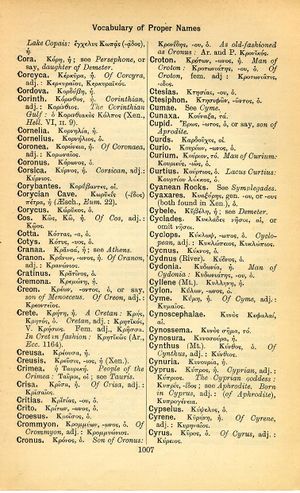Cyclops: Difference between revisions
Μαστιγίας ἔγχαλκος, ἀφόρητον κακόν → Pecuniosus verbero, malum maximum → Ein reicher Taugenichts, wie unerträglich schlimm
(Names) |
(6_4) |
||
| Line 3: | Line 3: | ||
<b class="b2">Cyclopean</b>, adj.: [[Κυκλώπειος]], [[Κυκλώπιος]]. | <b class="b2">Cyclopean</b>, adj.: [[Κυκλώπειος]], [[Κυκλώπιος]]. | ||
}} | |||
{{Lewis | |||
|lshtext=<b>Cȳ̆clops</b>: ōpis (acc. -ōpem or -ōpa), m., = [[Κύκλωψ]]> (a [[round]] [[eye]]),<br /><b>I</b> a [[Cyclops]]; in <[[number]] opt="n">plur.</[[number]]>: Cyclopes, um, the Cyclopes, a [[fabulous]] [[race]] of giants on the [[coast]] of Sicily; said to [[have]] [[each]] [[but]] one [[eye]], and [[that]] in the [[middle]] of the [[forehead]]; to [[them]] were ascribed the walls called Cyclopean; plur., Cic. Div. 2, 19, 43; Plin. 7, 56, 57, §§ 195-198; Verg. A. 6, 630; 8, 424; Hor. C. 1, 4, 7; Ov. M. 3, 305 et saep.; <[[number]] opt="n">[[sing]].</[[number]]> κατ ἐξοχήν, the [[Cyclops]] [[Polyphemus]], Verg. A. 3, 617; Hor. A. P. 145; Ov. M. 13, 744 sq.; 14, 174 sq.; Cic. Verr. 2, 5, 56, § 146 et saep.: Cyclopa saltare, to [[imitate]] [[Polyphemus]] by pantomime, Hor. S. 1, 5, 63; so, moveri, id. Ep. 2, 2, 125 Orell.— Hence,<br /><b>II</b> Adj.<br /> <b>A</b> Cȳ̆clōpēus, a, um, = [[Κυκλώπειος]]>, Cyclopean, of the Cyclopes; [[only]] plur as subst.: Cȳ̆clōpēa, ōrum, n., the [[myth]] of the Cyclopes as represented in a pantomime: ludere, Treb. Poll. Gall. 8, 3; Vop. Carin. 19, 3.—<br /> <b>B</b> Cȳ̆clōpĭus, a, um, adj., of or pertaining to the Cyclopes: saxa, in Sicily, Verg. A. 1, 201: at [[Mycenae]], Sen. Herc. Fur. 997: regna, Sil. 14, 33. | |||
}} | }} | ||
Revision as of 08:27, 13 August 2017
English > Greek (Woodhouse)
Κύκλωψ, -ωπος, ὁ.
Cyclopean, adj.: Κυκλώπειος, Κυκλώπιος.
Latin > English (Lewis & Short)
Cȳ̆clops: ōpis (acc. -ōpem or -ōpa), m., = Κύκλωψ> (a round eye),
I a Cyclops; in <number opt="n">plur.</number>: Cyclopes, um, the Cyclopes, a fabulous race of giants on the coast of Sicily; said to have each but one eye, and that in the middle of the forehead; to them were ascribed the walls called Cyclopean; plur., Cic. Div. 2, 19, 43; Plin. 7, 56, 57, §§ 195-198; Verg. A. 6, 630; 8, 424; Hor. C. 1, 4, 7; Ov. M. 3, 305 et saep.; <number opt="n">sing.</number> κατ ἐξοχήν, the Cyclops Polyphemus, Verg. A. 3, 617; Hor. A. P. 145; Ov. M. 13, 744 sq.; 14, 174 sq.; Cic. Verr. 2, 5, 56, § 146 et saep.: Cyclopa saltare, to imitate Polyphemus by pantomime, Hor. S. 1, 5, 63; so, moveri, id. Ep. 2, 2, 125 Orell.— Hence,
II Adj.
A Cȳ̆clōpēus, a, um, = Κυκλώπειος>, Cyclopean, of the Cyclopes; only plur as subst.: Cȳ̆clōpēa, ōrum, n., the myth of the Cyclopes as represented in a pantomime: ludere, Treb. Poll. Gall. 8, 3; Vop. Carin. 19, 3.—
B Cȳ̆clōpĭus, a, um, adj., of or pertaining to the Cyclopes: saxa, in Sicily, Verg. A. 1, 201: at Mycenae, Sen. Herc. Fur. 997: regna, Sil. 14, 33.

